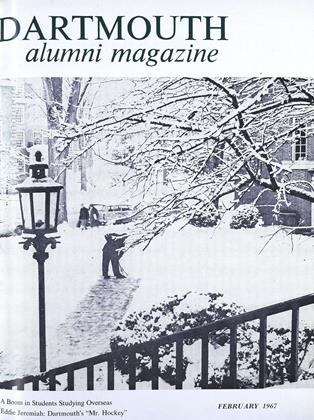By PageSmith '4O. New York: Alfred A. Knopf,1966. 332 pp. $6.95.
Many attempts have been made to explain American history, notably that by Turner some 75 years ago with the theory of the influence of the frontier. Once the accepted explanation, it was challenged by some who saw the American way coming out of the cities, or by others who preferred to think of changes caused by people moving to the cities, to the suburbs, to anywhere but not just to Turner's frontier.
Now Mr. Smith, the distinguished author of John Adams, and head of Cowell College at Santa Cruz, offers another explanation in the influence of the small town, as it started in the east and spread westward. In doing so, he speaks primarily of what he calls the colonized town, created through the deliberate acts of some cohesive group, and of the covenanted town, existing with some idea of compact among its inhabitants, with each other and usually with God. In such a town, he says, most Americans lived down to the start of the present century, and so it becomes important to find out what the towns were like in order to know why we are the way we are today. Throughout his book, Mr. Smith constantly raises interesting ideas, and offers interesting answers to some of them. The temptation to write an extensive review testifies to that statement, and there can be no doubt that much more attention should be paid by historians to the small towns. Here, in an exploratory way, Mr. Smith has read widely, and offers much.
Since he also says he is offering only conjectures and hypotheses, it is perhaps unfair to take any issue with them. He does insist that the small town was "the basic form of social organization experienced by the vast majority" down to 1910 or so. Certainly one might also say that till well into the nineteenth century most Americans lived on farms, and while in some ways farm life and small town life were alike, in many ways they were not, a point Mr. Smith had some trouble with in Chapter X.
Indeed, the need for further study of the town is, in a way, clearly shown by the whole book, which seems to me to alternate between genuine perception of what small towns were like, and real open spaces. For example, the chapter on town politics is not quite right to the eye of anyone who has seen even Hanover politics for 40 years, nor does Mr. Smith refer to such obvious sources as Grant's outstanding study of Kent, Connecticut, or Labaree's of New buryport, or Powell's on Sudbury.
In a chapter on temperance, he has Matthew Patten of Bedford, New Hampshire, drinking "enormous quantities" of rum, because he bought roughly a quart a week all fall and nineteen quarts on March 7. Even in New Hampshire a town leader had to provide drinks on Election Day, and in some places around here still does.
As a final point, the towns considered are New England towns, here and as New England spread west, and Mr. Smith so states. This does raise the question of the southern town and its influence as it too went west. But this is merely one more question raised by the book, and hopefully all will be answered, if not by Mr. Smith then by others stimulated by him to accepting the thesis that the small town, as well as the frontier and the city, had a part to play in our history.
Professor of History
 View Full Issue
View Full Issue
More From This Issue
-
 Feature
Feature"Mr. Hockey" By General Acclaim
February 1967 By CLIFFORD L. JORDAN JR. '45 -
 Feature
FeatureNous Étudiants à l'Étranger
February 1967 -
 Feature
FeatureMammalogist
February 1967 -
 Feature
FeatureSports Style-Setter
February 1967 -
 Feature
FeatureInternational Catalyst
February 1967 -
 Feature
FeatureCongressional Chronicler
February 1967
HERBERT W. HILL
-
 Books
BooksREVOLUTIONARY NEW HAMPSHIRE: AN ACCOUNT OF THE SOCIAL AND POLITICAL FORCES UNDERLYING THE TRANSITION FROM ROYAL PROVINCE TO AMERICAN COMMONWEALTH
October 1936 By Herbert W. Hill -
 Article
ArticleHanover Holiday, May 11-15
February 1942 By HERBERT W. HILL -
 Article
ArticleDARTMOUTH'S SKIPPER
June 1944 By HERBERT W. HILL -
 Books
BooksKENTUCKY PRIDE.
November 1956 By HERBERT W. HILL -
 Books
BooksMITRE AND SCEPTRE.
MARCH 1963 By HERBERT W. HILL -
 Books
BooksYESTERDAY'S RULERS: THE MAKING OF THE BRITISH COLONIAL SERV ICE.
OCTOBER 1963 By HERBERT W. HILL
Books
-
 Books
BooksAlumni Articles
MAY 1969 -
 Books
BooksSINCE 1900
May 1948 By Allen R. Foley '20. -
 Books
Books1 O'Clock in the Button Factory.
DECEMBER 1964 By CLIFF JORDAN '45 -
 Books
BooksTHE REPUBLIC OF SILENCE
June 1947 By Herbert F. West '22 -
 Books
BooksSOCIAL PROBLEMS
December 1950 By ROBERT GUTMAN -
 Books
BooksLETTERS ON THE ORNITHOLOGY OF BUENOS AYRES
July 1951 By Wedgwood Bowen
HERBERT W. HILL
-
 Books
BooksREVOLUTIONARY NEW HAMPSHIRE: AN ACCOUNT OF THE SOCIAL AND POLITICAL FORCES UNDERLYING THE TRANSITION FROM ROYAL PROVINCE TO AMERICAN COMMONWEALTH
October 1936 By Herbert W. Hill -
 Article
ArticleHanover Holiday, May 11-15
February 1942 By HERBERT W. HILL -
 Article
ArticleDARTMOUTH'S SKIPPER
June 1944 By HERBERT W. HILL


